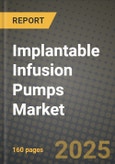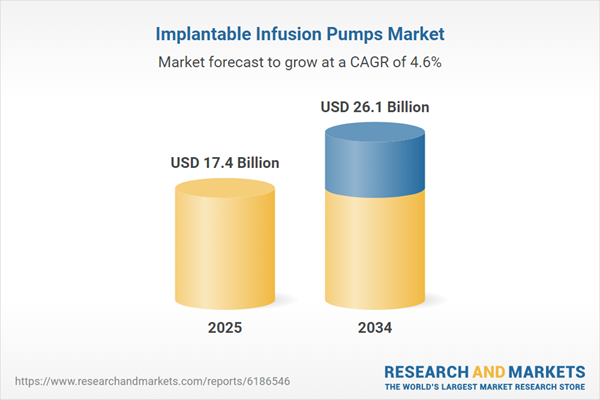The Implantable Infusion Pumps Market is a critical component of the medical device industry, focusing on devices that deliver controlled doses of medication directly into a patient's body over an extended period. These pumps are primarily used for the management of chronic conditions such as pain, cancer, diabetes, and hormone imbalances. Implantable infusion pumps are designed to provide targeted, consistent drug delivery, improving treatment efficacy while reducing the need for frequent injections. The market is growing due to the increasing prevalence of chronic diseases, advancements in pump technology, and the desire for more patient-friendly, minimally invasive therapeutic options. Additionally, as healthcare systems focus more on personalized medicine, implantable infusion pumps offer an effective solution for tailored drug delivery that matches the specific needs of individual patients.
The implantable infusion pumps market continued to evolve, with improvements in device design, materials, and functionality. Newer pumps featured enhanced battery life, smaller sizes, and more precise dosing capabilities. The introduction of pumps that could deliver multiple drugs simultaneously or deliver continuous infusion alongside bolus doses gained popularity, particularly in cancer and pain management. Additionally, the integration of wireless communication in implantable infusion pumps allowed for real-time monitoring and data sharing between patients and healthcare providers, improving treatment outcomes. There was also an increasing focus on patient comfort, with innovations that reduced the risk of infection, minimized pain during implantation, and improved ease of use. However, the cost of implantable infusion pumps remained a challenge, particularly in lower-income regions where healthcare access is limited.
The implantable infusion pumps market is poised for continued growth, driven by advancements in technology and increased demand for personalized care. The integration of AI and machine learning in the management of drug delivery is expected to make pumps smarter, allowing them to adjust medication dosages in real-time based on a patient's condition. As medical science advances, the use of implantable infusion pumps will likely expand to treat a broader range of conditions, including neurological disorders and autoimmune diseases. Furthermore, the market will benefit from innovations in non-invasive and less painful implantation techniques, making these pumps more accessible to a wider population. As healthcare infrastructure improves, particularly in emerging markets, the demand for implantable infusion pumps will continue to rise, leading to greater adoption globally.
Key Insights: Implantable Infusion Pumps Market
- Increased use of wireless communication for real-time monitoring and remote adjustment of drug delivery settings.
- Development of multi-drug infusion pumps capable of delivering various treatments simultaneously for improved therapeutic outcomes.
- Growing emphasis on patient comfort and ease of use, including innovations in non-invasive implantation and pain management.
- Integration of AI and machine learning to personalize drug delivery and make real-time adjustments based on patient data.
- Advancements in miniaturization, leading to smaller, more discreet pumps that provide greater patient convenience and comfort.
- Increasing prevalence of chronic conditions such as pain, cancer, and diabetes is driving demand for continuous and targeted drug delivery systems.
- Technological advancements in pump design, including improved accuracy, battery life, and remote monitoring capabilities, are enhancing market growth.
- Patient preference for minimally invasive, personalized treatments is leading to greater adoption of implantable infusion pumps in chronic disease management.
- The expanding focus on personalized medicine and treatment regimens that require tailored drug delivery is boosting market demand.
- The high initial cost of implantable infusion pumps and ongoing maintenance can limit accessibility, particularly in low-resource healthcare settings.
- Potential complications such as infection, device failure, and the need for periodic replacements pose challenges to long-term patient outcomes and device reliability.
Implantable Infusion Pumps Market Segmentation
By Type
- Patient-Controlled Analgesia (PCA) Pumps
- Enteral Pumps
- Insulin Pumps
- Elastomeric Pumps
- Syringe Pumps
- Other Types
By Applications
- Oncology
- Pediatrics/Neonatology
- Gastroenterology
- Hematology
- Diabetes
- Other Applications
By End User
- Hospitals
- Ambulatory Surgical Centers
- Specialty Clinics
Key Companies Analysed
- Medtronic plc
- Boston Scientific Corporation
- Nevro Corp
- LivaNova PLC
- Baxter International Inc.
- B. Braun Melsungen AG
- Fresenius Kabi AG
- Smiths Medical a Smiths Group company
- Terumo Corporation
- Johnson & Johnson
- Greatbatch Medical
- NeuroPace Inc.
- Primetech Corporation
- Flowonix Medical Inc.
- F. Hoffmann-La Roche Ltd
- Shenzhen Mindray Bio-Medical Electronics Co. Ltd.
- Micrel Medical
- Insulet Corporation
- ICU Medical Inc.
- Becton Dickinson and Company (BD)
- Roche Diagnostics International AG
- Abbott Laboratories
- Hospira
- Stryker Corporation
- Zimmer Biomet Holdings Inc.
- Teleflex Incorporated
- C. R. Bard Inc.
- AngioDynamics Inc.
- Merit Medical Systems Inc.
- NIPRO Medical Corporation
- IRadimed Corporation
- Zyno Medical
- Tricumed Medizintechnik GmbH
- Q Core Medical Ltd.
- Ivenix Inc.
- Tandem Diabetes Care Inc.
Implantable Infusion Pumps Market Analytics
The report employs rigorous tools, including Porter’s Five Forces, value chain mapping, and scenario-based modeling, to assess supply-demand dynamics. Cross-sector influences from parent, derived, and substitute markets are evaluated to identify risks and opportunities. Trade and pricing analytics provide an up-to-date view of international flows, including leading exporters, importers, and regional price trends.Macroeconomic indicators, policy frameworks such as carbon pricing and energy security strategies, and evolving consumer behavior are considered in forecasting scenarios. Recent deal flows, partnerships, and technology innovations are incorporated to assess their impact on future market performance.
Implantable Infusion Pumps Market Competitive Intelligence
The competitive landscape is mapped through proprietary frameworks, profiling leading companies with details on business models, product portfolios, financial performance, and strategic initiatives. Key developments such as mergers & acquisitions, technology collaborations, investment inflows, and regional expansions are analyzed for their competitive impact. The report also identifies emerging players and innovative startups contributing to market disruption.Regional insights highlight the most promising investment destinations, regulatory landscapes, and evolving partnerships across energy and industrial corridors.
Countries Covered
- North America - Implantable Infusion Pumps market data and outlook to 2034
- United States
- Canada
- Mexico
- Europe - Implantable Infusion Pumps market data and outlook to 2034
- Germany
- United Kingdom
- France
- Italy
- Spain
- BeNeLux
- Russia
- Sweden
- Asia-Pacific - Implantable Infusion Pumps market data and outlook to 2034
- China
- Japan
- India
- South Korea
- Australia
- Indonesia
- Malaysia
- Vietnam
- Middle East and Africa - Implantable Infusion Pumps market data and outlook to 2034
- Saudi Arabia
- South Africa
- Iran
- UAE
- Egypt
- South and Central America - Implantable Infusion Pumps market data and outlook to 2034
- Brazil
- Argentina
- Chile
- Peru
Research Methodology
This study combines primary inputs from industry experts across the Implantable Infusion Pumps value chain with secondary data from associations, government publications, trade databases, and company disclosures. Proprietary modeling techniques, including data triangulation, statistical correlation, and scenario planning, are applied to deliver reliable market sizing and forecasting.Key Questions Addressed
- What is the current and forecast market size of the Implantable Infusion Pumps industry at global, regional, and country levels?
- Which types, applications, and technologies present the highest growth potential?
- How are supply chains adapting to geopolitical and economic shocks?
- What role do policy frameworks, trade flows, and sustainability targets play in shaping demand?
- Who are the leading players, and how are their strategies evolving in the face of global uncertainty?
- Which regional “hotspots” and customer segments will outpace the market, and what go-to-market and partnership models best support entry and expansion?
- Where are the most investable opportunities - across technology roadmaps, sustainability-linked innovation, and M&A - and what is the best segment to invest over the next 3-5 years?
Your Key Takeaways from the Implantable Infusion Pumps Market Report
- Global Implantable Infusion Pumps market size and growth projections (CAGR), 2024-2034
- Impact of Russia-Ukraine, Israel-Palestine, and Hamas conflicts on Implantable Infusion Pumps trade, costs, and supply chains
- Implantable Infusion Pumps market size, share, and outlook across 5 regions and 27 countries, 2023-2034
- Implantable Infusion Pumps market size, CAGR, and market share of key products, applications, and end-user verticals, 2023-2034
- Short- and long-term Implantable Infusion Pumps market trends, drivers, restraints, and opportunities
- Porter’s Five Forces analysis, technological developments, and Implantable Infusion Pumps supply chain analysis
- Implantable Infusion Pumps trade analysis, Implantable Infusion Pumps market price analysis, and Implantable Infusion Pumps supply/demand dynamics
- Profiles of 5 leading companies - overview, key strategies, financials, and products
- Latest Implantable Infusion Pumps market news and developments
Additional Support
With the purchase of this report, you will receive:- An updated PDF report and an MS Excel data workbook containing all market tables and figures for easy analysis.
- 7-day post-sale analyst support for clarifications and in-scope supplementary data, ensuring the deliverable aligns precisely with your requirements.
- Complimentary report update to incorporate the latest available data and the impact of recent market developments.
This product will be delivered within 1-3 business days.
Table of Contents
Companies Mentioned
- Medtronic PLC
- Boston Scientific Corporation
- Nevro Corp
- LivaNova PLC
- Baxter International Inc.
- B. Braun Melsungen AG
- Fresenius Kabi AG
- Smiths Medical a Smiths Group company
- Terumo Corporation
- Johnson & Johnson
- Greatbatch Medical
- NeuroPace Inc.
- Primetech Corporation
- Flowonix Medical Inc.
- F. Hoffmann-La Roche Ltd.
- Shenzhen Mindray Bio-Medical Electronics Co. Ltd.
- Micrel Medical
- Insulet Corporation
- ICU Medical Inc.
- Becton Dickinson and Company (BD)
- Roche Diagnostics International AG
- Abbott Laboratories
- Hospira
- Stryker Corporation
- Zimmer Biomet Holdings Inc.
- Teleflex Incorporated
- C. R. Bard Inc.
- AngioDynamics Inc.
- Merit Medical Systems Inc.
- NIPRO Medical Corporation
- IRadimed Corporation
- Zyno Medical
- Tricumed Medizintechnik GmbH
- Q Core Medical Ltd.
- Ivenix Inc.
- Tandem Diabetes Care Inc.
Table Information
| Report Attribute | Details |
|---|---|
| No. of Pages | 160 |
| Published | October 2025 |
| Forecast Period | 2025 - 2034 |
| Estimated Market Value ( USD | $ 17.4 Billion |
| Forecasted Market Value ( USD | $ 26.1 Billion |
| Compound Annual Growth Rate | 4.6% |
| Regions Covered | Global |
| No. of Companies Mentioned | 36 |









